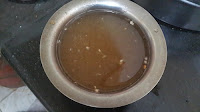It's going to be a fortnight since Deepavali is over here
but still I am full tight with house chores and never find any time to spend on
blogging. A lot of posts has been in the
hand to blog, of course.
I know it is quite late to post the deepavali recipes but
I thought its better late than never and my purpose of blogging was to document
my experience and experiments of my kitchen rather than an urge to post the
recipes. I have to manage home, work,
and house chores which takes a higher priority than this as usual. Also it had been raining like cats and dogs
in Chennai whole last week and first time in history all IT companies declared
an emergency holiday due to the flood situation and there were frequent power
cuts and network issues. There was knee
level water everywhere and it was a memorable experience to us.
Moving on to the recipe, I was longing to prepare this
halwa for a long time and was bit hesitant to try it without supervision of Mom
for some reasons. Since Mom was here for
Deepavali, I requested her to lend a helping hand as I also thought to take
step by step pictures for blogging purposes and she readily agreed. The outcome was perfect and whole family
enjoyed it. It is a bit elaborative
process but worth trying it. I suggest
you to try in small quantity as it involves long time stirring.
DH suggested that had the sweetness be little less, it
would have been even more delicious so I suggest you to try lessening the sugar
a bit based on your family sweet tooth.
Ingredients:
Samba Wheat - 2 cups
Sugar - 5 cups
Ghee: 2.5 cups
Artificial color powder - a pinch
(optional)
Cashew nuts - 20
To Grind:
Sugar: 5 tsp
Cardomom - 5-7
Preparation:
1. Wash and soak the whole wheat overnight
(~8 hours).
2. Drain the water to a vessel, and
grind it adding little by little water. Filter it using a metal strainer and again
grind the remaining pulp with remaining water and strain again. Repeat this until all the milk is taken from
the wheat berries. Mostly in two
strains, the pulp would be without milk.
3.
Keep the collected milk aside for 6-8 hours undisturbed. This process would separate the milk and
water.
4. Before the start of the process, filter the water which is settled at
the top carefully.
5.
In a mixer, powder finely 5 tsp of sugar and cardamom.

6. Fry the cashews in little ghee.

7. In a heavy bottomed vessel, add
sugar with little water and switch on the flame and keep stirring.

8. Once all the sugar granules are dissolved fully, add the extracted wheat milk and keep stirring. After sometime, slowly the color starts to
change beautifully as and when the sugar and milk gets cooked.

9. If you feel like adding food color, add the coloring powder at this time. Add the powdered sugar-cardamom mixture and keep stirring.
10. Slowly the halwa will go on to the semi solid state. Add ghee little by little. The ghee will be absorbed immediately, hence add little by little.
11. At
one stage, the whole halwa will start to
thicken and the ghee would not be absorbed anymore. You could see the glossy look and
crystallized sugar sedimentation at the top of the halwa. This is the right consistency to switch off
the flame.
12. Allow it to cool down for an hour and the consistency would further be thickened a bit.
13. Offer to God and enjoy a spoon of
yummylicious homemade halwa; you would realize the taste would last long in
your mouth....






































































